#it requires the narrative to set them up in a very particular way where you're forced to read them as romantic
Explore tagged Tumblr posts
Text
i think some folks may need to have the word "queerbaiting" revoked from their vocabulary until they learn what it means. perhaps
#soda offers you a can#i would not make anyone watch bbc sherlock bc im not a monster but that show defines queerbaiting at every turn#two characters having a deep and meaningful relationship is not queerbaiting by itself#it requires the narrative to set them up in a very particular way where you're forced to read them as romantic#only for that same narrative to deny the existence of any romance repeatedly#bbc sherlock deliberately leads the audience to believe there's romantic tension between sherlock and john#from side characters etc repeatedly assuming they are a couple to some Very deliberate scenes#that would immediately be painted as obvious romance if one of them was a woman#however it also insists on the heterosexuality of both john and sherlock by setting the former up with several girlfriends#and turning irene adler into a quirky little crush for sherlock (who also cures her of being a lesbian i guess)#and obviously john gets a wife but she must be killed off so the homosexual tension between john and sherlock can resume#and we can keep guessing if they end up together or not#they won't. but the writing very deliberately lead the audience to believe this#that's like. shit the defines queerbaiting#it's not Real Human People not telling the world they're queer#and it's not two characters having a relationship that's got more depth than a kiddie pool#sorry. new pet peeve unlocked. or old one rediscovered im not sure
17 notes
·
View notes
Note
Is Valentino Rossi the best rider in 1vs1 battles?
ehhhhh *shrugs* I mean. the best ever? like. who knows. the best in the field most years he was competing in the sport? maybe, I guess?
this is one of those questions where I don't really like giving definitive answers but am more interested in how you'd even go about assessing it? like, what metrics are you looking at, what are the criteria, can you put numbers to it or do you have to be super holistic about it or what. I think the 1 vs 1 is already an interesting distinctions, because that is a little different from just talking about wheel to wheel skill. they're related skill sets, but it's not the exact same
so. to bring in an example with a sample set of races I imagine most people reading this are pretty familiar with. let's say we're comparing valentino and marc in direct combat with each other. let's say we put the races where they're fighting one-on-one for basically the entire race in one box, so assen 2015 and catalunya 2016. let's say we have races where one of them is working their way through the field - and it's all building towards the confrontation between the two of them, so say a qatar 2013, a qatar 2014, an argentina 2015. let's say you have a very intense fight that doesn't last the whole race, like sepang 2015, or an extended 'duel' that is basically a defensive ride without any actual overtakes, like silverstone 2015. now, you may have noticed that from this list, valentino... kinda wins a lot of these? not qatar 2014, plus sepang 2015 is in the 'this cost both riders too much to have a winner' camp, but except for that? it's a strong record for valentino. however! the moment you take away the '1 vs 1' qualifier, suddenly the record looks way kinder to marc - you have a catalunya 2014, a phillip island 2015 and a phillip island 2017 go in his favour, while only assen 2017 is a multi-rider dogfight that involves both of them where valentino ends up taking the win. I do think when you're considering 'rivalries' and how a particular dynamic develops over time, it's worth looking specifically at what's happening in extended one-on-one combat and differentiating that from dogfights! because it is a different vibe, because it matters if you're just focused on one guy. but of course both categories still matter in assessing direct combat... even if there are also different skills involved in those different types of fights. valentino, even very late in his career, was still particularly adept at challenging and outsmarting individual riders, and it's a specific format he clearly did thrive in. so. yeah. both of these general categories are indicative of w2w ability, even if they're not quite the same - either in terms of the skills required or in terms of narrative implications
here's another issue. valentino tends to win the race-deciding extended confrontations against marc, but obviously that too isn't entirely reflective of what happened when they met each other on-track. this is because during their time together in the premier class, marc was winning a lot more races than valentino and generally had more pace than valentino, so a lot of on-track confrontations that marc came on top of where typically one-and-done type situations. overtake and move on, overtake and move on. so while you still have a misano 2014 (valentino overtakes marc and marc eventually crashes while attempting to keep up) or a brno 2014 (another valentino overtake where he pulls clear), you then also have laguna 2013 (the corkscrew move is the end of that battle), le mans 2014 (a single overtake around halfway through the race after which marc easily pulls clear), indy 2014 (an early tussle that eventually becomes more marc domination), motegi 2016 (similar, except here valentino ends up crashing), thailand 2018 (valentino can't keep up the pace once marc has gotten past)... like, we get to a place where we're risking penalising marc for 'being very fast' and not sticking around once he's gotten the overtake done, which does also feel wrong? it's an odd balance - because, again, when we're talking Actual Rivalries then it does matter who is winning an extended battle, psychologically if nothing else. like if that's the bit that mattered the most to the outcome of your race, if that's the bit people will remember years to come, if you invested a lot into winning that fight, of course it does matter. but that's narrative, not skill... is this really a good way of assessing how good someone is at 1 vs 1 duels?
I picked the example of that specific rivalry not just because it's the one most people are most familiar with or because I love engaging in discourse about that rivalry - but because I think direct rivalry comparisons are probably the most straightforward way you can approach trying to figure out who is 'better'... and marc clocks in just behind casey as the one who has the most balanced record against valentino w2w. like, biaggi is basically a walkover, and honestly you don't really have that many extended 1 vs 1 duels except for welkom 2004. and for sete, obviously a great rivalry (and I've always believed you don't need a rivalry of equals for it to be good and fun), but also once you get past that sachsenring 2003 turning point then the balance does go out of the window. I've been thinking about this in relation to a longer ask I've ended up massively overthinking (surely not), but I was kinda startled looking back at just how one-sided valentino's record is against jorge. like, unless I'm forgetting some major battles, the most extended scrap you can point to that jorge won is for his very first premier class win at estoril 2008 - and that's also pretty much settled by around halfway/two thirds through the race. but the actual 1 vs 1's that last much of the race? catalunya 2009? sachsenring 2009? motegi 2010? well.... hm. races that build to a battle like sepang 2010 also go in valentino's favour, and even extended tussles like le mans 2011 and phillip island 2014 are more valentino W's. hell, even various short and sweet battles like jerez and indy 2008, misano 2009, motegi 2015, aragon 2016, sachsenring 2018 generally have valentino come out on top - though in this category there's some exceptions, like qatar 2008, indy 2009 and jerez 2010 that all involved jorge besting valentino in a short direct fight
which raises another problem... we do need to in some way acknowledge that valentino simply ends up in more of these fights than most of his rivals - and as a direct result ends up winning more of them. like, once jorge clicked into title winning form in 2010, most of his wins became 'shoot off the line and win way ahead of everyone else with metronomic consistency'. I'm not saying all his race wins were like that! and he did win some great duels in his time in the premier class, especially against marc. but of course, he did that kind of dominating races a hell of a lot more than valentino did - whose approach to winning races was more 'qualify wherever, amble off the line, get moving around halfway through the race and figure things out from there'. now, I discussed this point a little bit here in the context of 'was valentino still successfully mind gaming the other aliens' - but just to bring it back, valentino was deliberately approaching his races in ways geared primarily towards being able to fight his opponents, even to the level of how he set up his bike:

you see this most extremely with something like laguna 2008, where valentino flat out knew he didn't have the outright pace to win - his entire strategy was built around not being the fastest but being able to fuck with casey. in that situation, he's not got the speed, he's building his entire strategy for the win around wheel-to-wheel disruption. and this, plus the regularly mediocre qualifying and starts, does just mean that statistically speaking he's overtaking more riders in his average win than any of the other aliens are. like, if that's your primary metric, then yes! he's clearly very good at w2w! by extension he's also very good at 1 vs 1 duels! if you're looking at riders who have clocked in more than a certain number of wins and do the maths of average overtakes per win, then, yes, I would imagine he tops that metric. does that make him the best? ... well, again... it does feel like you're risking penalising the better qualifiers and starters for being better qualifiers and starters and not ending up in seventh place at the end of every single first lap
so, you've got 'how they measure up against their direct rivals' and 'average numbers of overtakes' as ways to begin considering w2w ability as well as 1 vs 1 track record. then you get into increasingly nebulous waters... here's another potential metric for w2w skill I quite like: efficiency in overtaking. not naming any names, but there are certain riders who, when attempting to work their way through the field, will just. get stuck. even though they have a clear pace advantage over the rider directly in front of them. leading to incredible amounts of faffing about rather than just getting the overtake done. obviously, valentino does like to engage in some faffing about too, but generally speaking he's only doing that when he's in close proximity to the race leader and can realistically get himself to the front of the pack fairly quickly. he's very efficient when he's actually working his way through the field. of course, this is something marc is similarly excellent at, as he has shown plenty of times this year... which. well. this is where we run headfirst into another problem: this sport has changed a lot over the years and some things are simply not at the same difficulty level as they were in past years. so, sticking with those two, which of these is a 'better' comeback? 2006 sachsenring, where valentino starts tenth on the grid after tyre problems in qualifying, at a track he doesn't really love and in serious championship trouble, but works his way to the front before having to fend off the chasing pack that is coming back at him all the way until the chequered flag? or 2024 sachsenring, where marc starts thirteenth on the grid after having been impeded in q1, at his speciality circuit that he's visiting for the first time on a new bike, and works his way up to p2 despite his fractured rib and finger in an era where overtaking is a lot harder than it was in 2006? well, first of all, congrats to both of them, very nicely done. but secondly, that's kind of the problem, right? while I'm sure prime valentino in this era would also regularly be doing that marc/pedro thing where they make the commentators go 'oh ho ho they said overtaking was impossible in motogp these days!!' - at the end of the day his approach involved some built-in faffing about that was also more feasible back in the day. if we're assessing w2w ability, we do need to make some kind of allowance for era - which also affects how often riders are likely to find themselves in 1 vs 1 duels in the first place
here's another plausible metric: last lap battles. this is ALSO something that is super era-dependent. casey in his whole time in the premier class gets involved in like? about four battles that are still going on in the final lap? there's definitely a few I'm forgetting, especially if they weren't for wins/podium places, but it's definitely not a lot. compare and contrast with how the 2017 to 2019 era played out. everything back then was tyre management, tyre management and more tyre management, and dovi in particular was big on the 'eh let's win this race at the slowest possible pace' thing, where everyone crawled around the track as slowly as they could get away with before pulling the pin a few laps before the end. obviously, the characteristics of that era were a) very beneficial to dovi, in that they rewarded both those who knew how to make those specific tyres work (and his decline in 2020 was largely linked to the changes in tyres) and those who were very good at managing last lap duels, but b) inherently were more likely to produce last lap duels than a few other eras. like, in the alien era, which regularly featured gaps of. idk. seven seconds between the front runners, the characteristics of those bikes (as well as those riders) just meant you had very few battles that lasted that long. so inherently, it's harder to judge riders like, say, casey on how good they are in that kind of situation, not least because you are working with such a tiny sample size. and those battles are a big feature of how we remember 1 vs 1 duels!! people love last lap duels!!
now, yes, obviously valentino's record in 1 vs 1 last lap duels is very strong, and there's really only a few he loses over the course of his entire career. dovi is another strong contender in that particular category if we're just limiting ourselves to riders this century (which we are). (unfortunately, those two kinda took turns to be competitive so we didn't really get much of a direct h2h, but off the top of my head I think it's a pleasing 2-2? dovi takes qatar 2008 and le mans 2011, valentino takes qatar 2015 and argentina 2019. I feel like I'm definitely forgetting something.) but again, you do end up in caveat central with this metric. look at marc, who was reliably finding himself in last lap duels specifically at tracks he and/or the honda were quite poor at - again, ragging on that record too much does feel like you're penalising him for managing to get there in the first place. on the other hand, is it really fair to take too much credit away from dovi in handling those situations - surely, at the point where you're arriving in the last lap together, you're at a stage where both riders have a decent chance of winning? on the third hand, it is worth pointing out that dovi is more often than not in the lead going into those last laps, and is fending off a sort of on-the-edge last gasp 'might as well have a go' marc attack. 'last lap battles' is inherently quite a loose term, and how much should who's leading going in be considered a criterion? does it matter if you actually have an overtake or not? does it matter when in the lap the overtake happens? it's obviously quite an arbitrary category... sete makes a mistake headed into the last lap at sachsenring 2005 that gives valentino the lead, while marc makes a mistake on the penultimate lap of catalunya 2016 that essentially ends his victory challenge towards valentino. how do you compare those?
and at a certain point, you need to get away from the headline numbers and start thinking about what it actually means to be good at 1 vs 1 duels. you get into categories like 'race management' - choosing when best to make your attack, balancing risk and reward, not making risky overtake attempts for no good reason when you could just wait for half a minute longer, making sure not to needlessly fuck your tyres while pushing too hard too early. there's ability to actually execute overtakes, which is a question of race craft, creativity, and also about being able to play the opponent. there's various defensive abilities - somebody like pecco exemplifies this, who is both very hard to initially overtake in part due to his ability on his brakes, but is also adept at immediately re-overtaking (a favourite trick of his mentor too, as it happens). to borrow from another sport's terminology, you can contrast 'conversion' and 'steal' rate - if you have the superior underlying pace at crucial stages of the race, are you actually converting that into your maximum achievable result, or conversely if you have inferior pace, can you steal a result your pace doesn't 'merit'? obviously, you get a massive blot in the copy book every time you fail to convert any kind of result by crashing out or by bagging yourself a severe penalty for your race conduct. what about the psychological dimension? your ability to put pressure on another rider, e.g. by showing them a wheel here or there, to force them into a mistake rather than 'just overtaking' them via pure skill? is reputation and intimidation part of your skill set when it comes to wheel to wheel ability? the off-track 'work' you're doing on the opponent, and the prior weight of their expectations for this fight... your ability to study and analyse riders to pinpoint where they are at their strongest and weakest, while also figuring out where they're going to expect an attack and where they won't - maybe even sucker them into thinking it will come from somewhere differently than it actually does... on sheer weight of his track record, you'd have to say valentino is pretty much peerless in some of these categories. and, yes, some of these skills are weighted quite clearly towards the '1 vs 1' element over the 'multi-rider dogfight' element of w2w skills. they're more about terrorising a specific rival than thriving in the chaos
so. what does all of this mean. what's the actual answer. is valentino the best at 1 vs 1 duels. well. who knows. even if we're ignoring the historical dimension and limiting ourselves just to this century, there's too many confounding factors - from different racing eras within that time span to different individual approaches to racing - to allow us to truly evaluate who the 'best' is. I think the cleanest way to summarise it is... from the great riders this century, valentino is the one who most depends on his 1 vs 1 skills (and w2w skills more broadly). that's his unique selling point in a way you wouldn't say it is for any of the others... the guy who gets closest is dovi - but I still reckon his biggest skill is his tyre management and that was the most important differentiating factor that made him so competitive in 2017-19. his ability to scrap w2w comes second (and is absolutely a constant throughout his career), but really that's the bit that allows him to take advantage of the tyre whispering skills... it lets him finish the job, if you will. whereas with valentino, his brains and cunning broadly speaking and his w2w more specifically - and especially the 1 vs 1 stuff - is like, his x factor. I mean... obviously he's also good at the other things - I called him a mid qualifier but of course it's worth remembering he has 55 career pole positions in the premier class, more than jorge or casey or dani. this is primarily a function of his longevity and all of them are definitely better qualifiers than him, but like. of course he's not slow. it's just that relatively speaking, when compared to the other aliens, he's the one who is winning the least via his actual raw pace. here's one metric for that: in valentino's seven premier class title campaigns, he only has the highest average grid position in only three (and during his super dominant 2002 season, it's joint with biaggi). in three of those title-winning seasons, he's the second best qualifier on average, and in one of them he's only third best. the only other seasons this century where the best qualifier on average doesn't win the title are 2015 (marc just beats jorge, valentino is quite a distant third), 2020 (joan mir icon winning a title with an average grid position of NINE POINT FIVE SEVEN lmaoooooo, only seventh best on the grid), 2022 (fabio is a little ahead of martin and then pecco) and... that's it
which kinda means that... can you say valentino's objectively better at 1 vs 1 battles than the other aliens? well, no. I mean, sure, I do feel fairly happy to say he's better than jorge and especially dani, more *wiggles hand* about casey and marc - because with those two there's enough confounding factors in comparing them to valentino and they've also challenged valentino often enough directly that you can make the alternative case. in the end you do kinda go... well, it's very much a 'all these guys were at their best in very different versions of motogp' thing. what you can say is that for valentino, 1 vs 1 prowess is a bigger part of his game than it is for his fellow aliens. his route to victory both on an individual race level and on a title fight level is built around engaging in a lot of these fights and winning them - and, given how successful he's been, of course you do have to conclude that bit of his game is clearly operating on a high level. so when you compare that to both casey and marc, those two really do have other bits of their games that are more important to their success. fewer of their race victories percentage-wise have been won through 1 vs 1 duels. casey is dominating enough races from the front he's not even doing all that much w2w tussling. marc might be losing plenty of these close duels, but he's relentlessly at the front enough that this consistency is what's giving him titles as much as anything else. whereas valentino's entire approach is tailored towards finding himself in those kinds of direct scraps, winning said scraps, and then using those scraps as a way to demoralise the opposition... unsurprisingly, he's got the biggest sample size of that style of battle and has a very high success rate. who knows if he's the best, but he is the most dependent on that specific skill. and he sure has had a lot of practise at those duels, which I imagine will have gotten him just a little closer to being perfect
#i do love athletes whose brains are their usp#though it's quite easy to... go too far in that direction. like valentino wasn't just mind beaming his way to all his wins#//#brr brr#batsplat responds#alien tag#clown tag#this is all incredible cowardice btw obviously i've ranked all the aliens in my notes by basically every imaginable metric#from qualifying to starts to w2w to mixed conditions to wet weather prowess etc etc etc. like i do also do it i just don't stand by it
15 notes
·
View notes
Text

Indie Xenofiction; Data Lion
"Data Lion is a short visual novel about a lion who gets a camera collar put on him by a group of scientists wanting to document his journey. It has choices, 2 love interests, and many alternate endings including bad ends (game overs)!
The idea was inspired by masterpieces like The Lion King and the manga/anime Kimba The White Lion."
Found this game while searching around on Itchio, the game is completely free to download and can be completed within just a few hours. It is described by the author as being unfinished in its current state, but I think it can be played through completely with a feeling of some satisfaction. Here is the link for those interested
More in depth review under the cut featuring spoilers. If you're looking to play I do recommend going in blind, it's fairly simple and the fun is really found in unlocking the CGs, which isn't too hard to do.
This is a short game that reminds me a lot of media I grew up with on dA back in the day, so it was very entertaining. I can definitely tell this takes a lot more inspiration from Kimba than it does TLK with a lot of its story concepts and overall character design. The game itself runs on a seven day cycle so it's fairly short.
I enjoyed the main character's design, he's an intersex, mostly maneless lion that you can name, though the default name that pops up is 'Lion McLionface' (your character was supposedly named via an Internet poll made by the scientists attaching your radio collar)
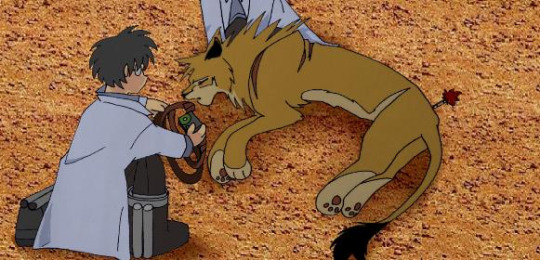
You're also able to choose your stats, as this game does have (extremely basic and limited) combat. For my playthrough I named the lion 'Lasaga' to be a bit silly and I dumped all my stats into strength.
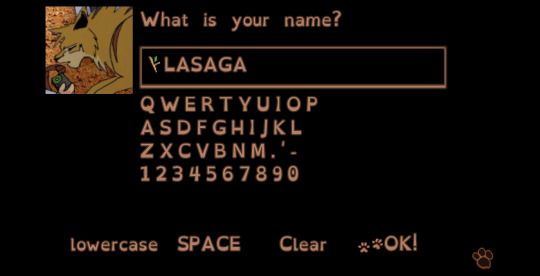

I'm not really sure what the stats of Skill and Speed do for you. I completed the game by getting all the CGs and didn't encounter anything that was explicitly skill or speed required, perhaps it has a factor in combat that I'm unaware of.
You make a series of choices, some meaningful some not as most of them lead to the same exact events playing out. You can acquire the only pickable item, a thorn you can use in combat, in the game earlier on based on where you choose to make your home if you pick the Acacia Tree.
At some point a Safari Car will come by and observe you, if you make the right dialogue choices you can get some exposition on the setting you're in.

The animals in this particular section of Africa are apparently Bio-Engineered to have heightened, near human intelligence. The author of the game, Caveboy Tup has elaborated in a comment on the game's itchio page which I'll leave below;
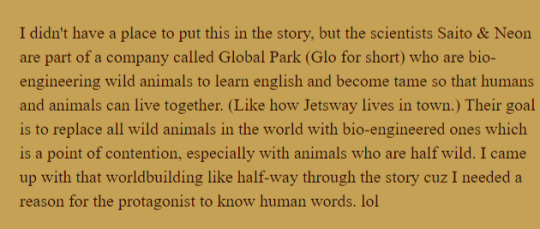
This is definitely something that shows a lot of Kimba inspiration though it goes in a different direction that has some interesting implications. I would have been interested to see this explored in a more elaborate narrative.
The two love interests in this game are Jetsway and Rrred;


Their routes are very straight forward, I'd say you would have to really go out of your way to not pursue either of them, which makes it easy to pick and choose which one you 'romance', as it's also pretty bare bones in that regard too.
The one most advertised is definitely Rrred the lion who is featured more prominently on the game's page. He's not got a whole lot of depth, you have the choice to fight him or join up with him in a coalition immediately upon meeting him.
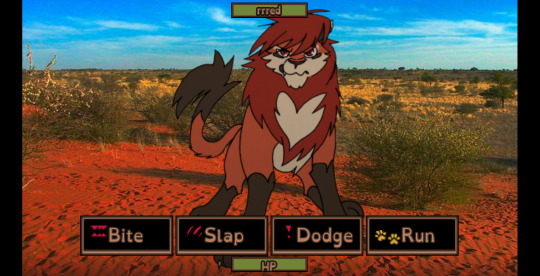

I do like the game's expression work, I find the animals emote in ways that are fun to look at and easy to read.
If you defeat him he will simply retreat and will show up again later to give some brief exposition on Jetsway's character.
Joining up with him starts his short route, which mostly consists of him scaring off crocodiles at the watering hole for you, which you are able to avoid without him regardless (The only time my character got a bad end was when I chose the wrong evasion option at this point in the story) The other portion is an encounter with a clan of hyenas that was pretty comedic, this got a good laugh out of me. It was the only time the game was particularly vulgar.

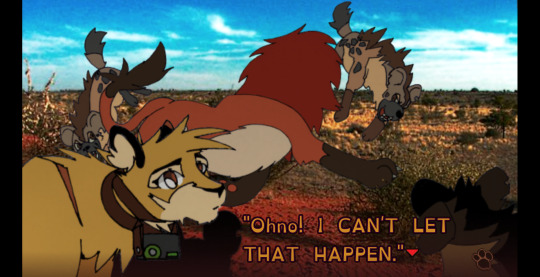
You escape the hyenas, as you are outnumbered no matter how high your strength stat is. The rest of the route is pretty uneventful, you travel together and it's implied there's some romantic interest between the two of you.


I will admit I found Rrred to be the less interesting of the two routes but I can see what appeal they were going for here.
The other route is Jetsway's which I found to have slightly more meat on its bones.
You meet Jetsway first in fact while looking for food but he only says that the radio collar you have on means you aren't one of his 'targets' before sprinting away.
Encountering him later finds him injured in the middle of the night after a fight.
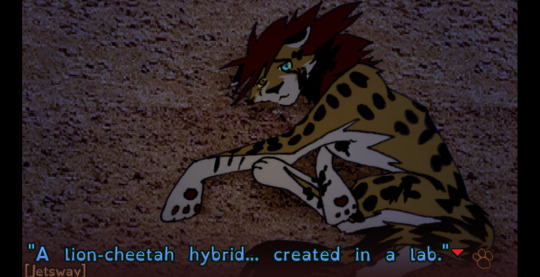
There's more lore exposition with Jetsway regarding the largely left out bio-engineering aspect. He's some creature part of Glo's work that was created by them, it's specified he has some sort of Tech in his eye that isn't explained very much.
Poking around the dialogue options with him will give you the option of fighting him once he reveals he got these injuries fighting and killing lions, which explains why he specified you weren't a target earlier.
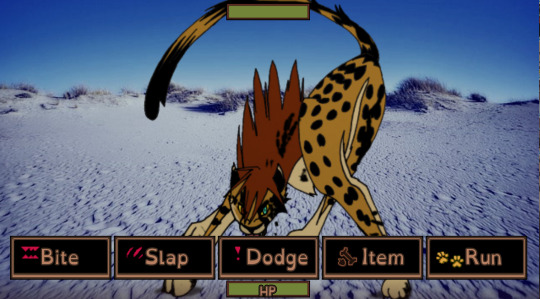
Upon defeating him, you can kill him here which I found interesting. But you can also choose to stay the night and nurse his wounds until he recovers.

You are given the option to walk him back home, and doing so will trigger an interaction between you two and Rrred, who calls Jetsway a murderer. Pushing Jetsway for more answers will only get you this in response.

There is no further elaboration on this plot point after this. I assume given the larger narrative that was mentioned by the creator that he's killing lions that are either human aggressive or resistant/unsuccessful in the Bio Engineering stuff. But that's only an educated guess.
Walking him home will after lead you to Utke town, where he says the humans will give him more medical treatment but that your character cannot stay.

You're able to stay the night, where you'll find Jetsway gone in the morning, but you are spotted by a Glo operative prior to this who takes this photo of you and Jetsway to 'share on the internet'.

After these two CG's, the final day is always the same. Your radio collar falls off on the seventh day and the scientists come to retrieve it. You have two options after this, to hide in wait to observe the humans at first, which will lead to you being tranquilized again while they retrieve your collar.
You can also attack the scientists, which will result in you ripping off the arm of one of them, the one named Saito.
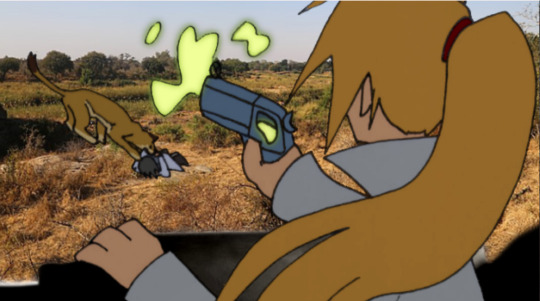
They escape you after this, and leads to the final CG where Saito has been given a replacement prosthetic arm.

This concludes the game as currently published. I found it very charming to play and a nice way to spend part of an afternoon. It was definitely worth sharing since I haven't seen anyone discuss playing it or knowing it exists.
32 notes
·
View notes
Note
as a TTRPG designer, how would you approach blackjack / a risk reward type mechanic (I am going to steal)
oh hell yea i genuinely love folks doin stuff like this, ideas are meant to be taken and ran with
and youre in luck cuz ive talked about this before w friends! i think push your luck mechanics fuckin rule in ttrpgs. something i think about a lot is how most dice-based ttrpgs have an actually pretty shallow skill ceiling. like, there's skill involved in making your build, and using your resources at the right time, but once you have your build and know how to spend resources a lot of the actual mechanical fabric of play is just rolling a die with as many modifiers on it as possible and hoping it passes the GM's threshold. there's not a lot of ownership over winning, and not a lot of regret in losing. so yea i think Blackjack's a real promising approach!
so lets talk about the actual meat and potatoes. what's Blackjack bringing to your game, what're the costs, and what's the design space?
Blackjack's letting you turn every roll into a meaningful gamble, where the players can decide how far they want to go and how much they want to risk to accomplish their goals. already that sets a kind of tone for the game, where PCs aren't really noble heroes (or, at the very least, they're noble heroes in a world that makes no effort to coddle them). failure is always a possibility, and disaster is always your fault.
in terms of costs, there's one real big one right off the bat: playing a minigame takes time and mental effort. this is the primary advantage of dice, you barely have to stop to roll a die and see if it was good or not. if you're playing Blackjack every time you do something, you're gonna get very little done. so you're gonna wanna make every game really count! the Blackjack only comes out when the stakes are big. Viditya Voleti describes a fun dice mechanic here where multiple actions from different players can be resolved with one check, and that's another way you could handle something like this.
so okay here's the fun part: design space. here's a first pass at a Blackjack ttrpg mechanic.
whenever you're in a tense situation with everything on the line, play a game of Blackjack. players may bet any amount of Strength, Stakes, and Survival, though some games may have minimum bets established by the dealer. the dealer chooses their face-up card from a hand of three, then deals their face-down card from the deck. when the round is over, the dealer pays out all bets, then describes how the gamestate has changed. if a player went bust, they fail catastrophically. their hubris comes crashing down on them. if a player lost to the dealer, they fail, but they're not out. they can push their luck and try again. if a player tied or beat the dealer, things go well for them. they pushed ahead, got what they wanted, and can try again for double or nothing. if a player got a Blackjack, they succeeded beyond their wildest expectations, double their winnings, and get full narrative control. Strength can be spent to buy new skills and abilities, to gain an edge in future games. Stakes can be spent to buy narrative beats, and many obstacles require payment before a certain number of games elapse. Survival is spent to mitigate the costs of failure and ensure your character doesn't meet an untimely end.
something i really like here is how the dealer gets some control over the difficulty of the check. once the game starts, they're still essentially automated, but they can choose to make a particular game easier or harder on the players. the three currencies also give some texture to each bet, and the GM can play this up by requiring certain minumum bets. a game against a brutal killer might cost 3 Survival upfront, so if you lose you're in a precarious place but if you win you'll be (temporarily) untouchable. it could also allow for a game world where multiple Blackjack games are present at a single time, offering different buyins and payouts to the players. they might be investigating a murder in a small town, and each suspect is represented by a potential Blackjack match. the antagonist of a long campaign might be available from the very start, sitting smugly behind an impossible game of incredible stakes, waiting for the players to build up the courage to take them down.
anyway, those are just a few thoughts on this! lmao
#ttrpgs#oh and naturally if you wanna take some or all of this go ahead#even if you're not the anon who asked#just give me a shoutout#oh and let me know cuz id love to check it out!
11 notes
·
View notes
Text
Adapting Machinations of Court and Frame into a VN-ish format
For Narrat Jam 2, I'm poking my ideas for a political, intrigue-based mecha game that cares deeply about ties between people with power into a little linear VN storyline. A TTRPG designed for PVP troupe-level play is pretty different from a story following one person! So I'm gonna think out loud about what I'm changing and why.
Ah no I'm writing another dicelessness article by accident oh god help
Off the bat, one of the technological aspects I ran into is that Narrat is very particular about skill rolls. They're binary in nature, you have to define how they work up front, and you don't get the roll value on a check, just pass/fail.
Now. I could possibly hack something together to account for this, it does have access to a generic random function. But honestly, I'm not gonna bother. Total//Effect's core mechanic is fine if you're a person looking at dice but kind of annoying when you're telling a computer "pick the middle of these three d6's, or the lowest or highest if a specific thing happens, but also we care about the sum of the three, and sometimes it's roll five and take the highest 3".
So in two different ways, the core mechanic changes. And these have other impacts, so we'll just go into those here...
Relationship changes
Relationships in Total//Effect compare a die of 3d6, based on the request being made, to the number of Bonds you have with the person. (Bonds in Machinations default are mutual and also add Tells to combat against each other.)
Dice rolls in TTRPGs are a tricky thing. It's very easy to add them because everyone's doing it and just as easy to forget why you're doing them. FANTASTIC article on this here. In core Machinations, Relationship rolls are a way of doing a push-pull on another character: if you succeed on that roll, you do something that influences them to act in a specified way, through whatever means your shared Bonds provide. But a mixed success gives them more narrative control about it, and a failure means they can potentially turn it around on you. In a tabletop setting, it's really easy to account for all those branching possibilities because a) you can just make shit up and b) in this case in particular, it's two players.
The thing with VNs, etc is that's a LOT of writing and uncertainty. Disco Elysium's great at this kind of random-branching but think about how much branching dialogue that takes. And that's a game where most checks can be re-tried later after gaining a skill level! In a more linear story, you could have a roll or two that just completely fucks your entire intent. (This is why you see people playing those games savescum like mad.)
I don't like that model very much! I prefer the Age of Decadence narrative model. In that, there's NO randomization. If you have 3 Persuasion and 3 Streetwise, you can always succeed at the check that needs 6 total. (That said, it conceals the check-required values from you, so you can still fail by just not having enough.)
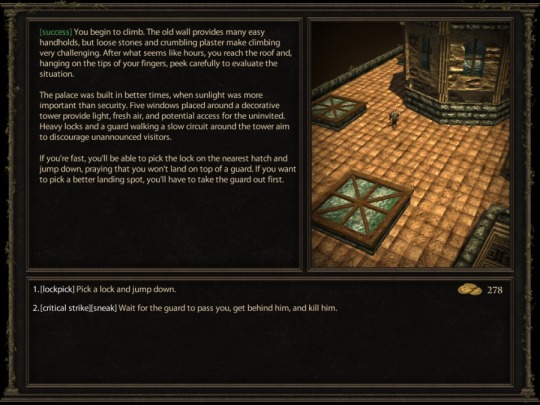
I'm going to make a small concession, which is letting folks reach beyond their grasp: a 1d3-1 (0-2) is attached on each relationship check. So if you've got a 5, you have a 66% chance of hitting a Difficulty 6 Check, or if you have a 4 it's a 33% chance, but you'll hit Difficulty 4 checks 100% of the time. (And I might gate a few of the more important Difficulty 6 checks behind a "you must be this tall to enter" anyway. Gotta commit if you want to do the most drastic things.)
Duel changes
Duels are not random at all. Ok, that's a lie, but the main randomization is the enemy "AI", not any of the outcomes. Once both moves are locked in, it's going to play out exactly as expected based on Priority (the rock-paper-scissors of Aggressive, Defensive, and Indirect that various moves have).
The big thing here is, again, creating interesting outcomes. My goal for combat is that failing one doesn't create a "do it again, stupid" scenario: I'm already planning to have failure outcomes for fights that move the story forward rather than force you to reload and try again. But again, I think it comes down to intent: in the context of tabletop, I think it's cool as hell that sometimes you can get some wildly swingy rolls that completely change a situation! MoCaF in tabletop form is going to largely give opportunities to be as equal as possible. But in the context of a single player game, I don't want it to be as all over the place. I'd much rather it be like a chess match: you pick the best you can based on the knowledge you have. And this extends to the Tells system: this is way more egalitarian in the tabletop game, as anyone you have a Bond with has as many Tells on your business as you have with theirs. Here, it's your special edge. You can definitely win fights without one but it's gonna be a hell of a lot less reliable. (Plus, that's an awful thing to program.)
I'm also not including escalation here, partially because I don't 100% know what to do with it in duels in tabletop, but partially because we don't really have rolls for it to influence.
One POV Character, Eight Predetermined Main Cast Members, Four Predetermined Houses
Machinations in concept is a very irregular TTRPG. Most have some idea of a single "group" that you follow: Machinations expects you to hop around various alliances and have players pull out their PCs from other alliances when they show up in their expected off-weeks to do politics, have intrigue, and fight.
For the sake of me being able to finish this game, you control one character here. Your relationships with those 8 other main cast members (four noble, four common) are the key concern. They relate to each other, of course, but that's in a non-mechanical sense (like they don't have capital-R Relationships tracked or anything, just what the narrative needs them to do).
Again, switching viewpoints would be cool! But holy shit is that a different proposition scope-wise. And ultimately it'd be way harder to do any kind of branching.
In the actual game, creating your own House is a thing! Each player creates two for the game as a whole. But in this, we're sticking with four predetermined:
House Alzur, an ancient House deeply invested in lineage from the first lightspeed traveler and steeped in tradition;
House Reyaal, new money from betting right on other Houses' conflicts;
House Montrant, a weapons-manufacturing House with eyes towards supply lines; and
House Weber, an extremely tiny house with a lot of connections: they own Amirus, the planet that the plot takes place on that all of the other 3 lay some claim on.
No Court Maneuvers and Status, but Backgrounds can matter
I'm eschewing Court Maneuvers entirely, just for complication reasons. But in their place, your starting Background (Scion/Knight/Captain) matters more directly!
Backgrounds tie into Status, which is a thing in the tabletop game but I'm leaving as more nebulous here. In the tabletop game having high Status is generally always good, but you get some benny points for being low-Status; in this, instead some situations will go better if you have less-blue blood.
Adaptation is interesting
I'm hoping I can get this one across the finish line. It's definitely ambitious but doable: most of the infrastructure is there, it's just a matter of filling in the branching tree.
3 notes
·
View notes
Note
I do feel like the writers care more about Robbys character then they do about Miguel’s tho
Do you? That's interesting. I have more often heard the opposite argument being made. I think the characters have equal significance to the overall story, though the writing priorities for them are very different. It's a bit of an apples-to-oranges comparison.
Johnny is the main character of the show (sorry, I love Daniel, but this ain't his story.) So, I view every character through that lens.
In this universe Johnny Lawrence is the sun and everyone revolves around him—which means there's an assumption the audience will be invested in Robby just by virtue of him being Johnny's son. With Miguel, we're seeing their entire relationship journey, so there's a heavier lift required to make the audience love that character, particularly in relation to Johnny.
So with Miguel you needed a lot more development up-front, whereas with Robby you play the long, series-wide game.
Miguel and Johnny meeting, Johnny rescuing him from bullies and then agreeing to teach him karate is the inciting incident of the show (Johnny getting arrested for doing the same exact thing that Miyagi did in KK is a hilarious reframe.) They are the "Bad Santa" surprising reboot of Miyagi and Daniel. So much of the premise of Cobra Kai and Johnny's identity as a teacher, which the show presents as his true talent and vocation in life, hinge on that relationship being compelling, genuine, touching and heartfelt. Which is why so much time in S1 and 2 in particular were spent developing it.
Robby, by contrast, is Johnny's biological son, entered the action of the story and all the other characters' lives because of that blood relationship (he started working for Daniel to provoke Johnny and he would have never met any of the characters if not for that connection.) So there's a lower burden placed on getting one "invested" in this relationship. If you care about Johnny—and if you're watching this show, you have to—then you want him to reconcile with his son.
We have comparatively few scenes between them, however. That's because their relationship has 16 years of history that happened before the events of the narrative, and the audience is expected to infer a lot about it, based on what we know about Johnny as a person and how Robby turned out/the obvious characteristics they share. You can get away with making Robby a juvenile delinquent who steals computers, rips people off, dabbles in drugs and skips school for the same reason you can make Johnny an alcoholic burn-out loser—the son takes after the father, and these "versions" of them are their worst selves they both desperately want to change. There's far less set-up required because a father and son relationship comes with a set of expectations and assumptions the writers are relying on the audience making and caring about.
(One of my biggest criticisms of the show is that they've made the degree to which Johnny has been involved in Robby's life way too vague, to the point where I see people argue that the hug in 4x10 is the first time they've ever embraced in their lives. I would have liked more of Shannon and Johnny's relationship history spelled out overtly —were they ever "together" in Robby's childhood, eg.?—because so much fandom discourse seems to derive from wildly different assumptions about this dynamic and how Robby's relationship with his parents and their relationship with each other has affected him.)
Robby's story is working as a parallel to his father, and there are constant, subtle and overt connections made between them, even though they have spent most of the first four seasons on "opposite sides" of the conflict from one another. I don't need a huge amount of interaction between them to know Johnny cares—the fact that he's got exactly two photographs in his apartment, one of his dead mother and his son's second grade soccer photo on his fridge, says it all.
TL;DR: Miguel is connected to Johnny's teaching, which is his redemption, whereas Robby is the symbol of his biggest failure in life. The Miguel dynamic is where a lot of the comedy of the show has landed, and Robby has largely been the heaviest drama. I see going forward a merging of these two storylines and a reversal of the dynamic (more Robby/Johnny comedy and more Johnny/Miggy drama!!)
#cobra kai#cobra kai meta#robby keene#miguel diaz#this turned into a treatise on how television writing works#johnny lawrence
44 notes
·
View notes
Note
Has there ever been a all myths are true story that doesn't portray Yahweh as a jackass and the other gods bitter at him like at least one story, please. I just want him to have more character than just asshole (supernatural doesn't count)
��This is another part of my previously ask but why is when most works not Christian mostly just portray Yahweh evil. Has there been as works that paints him a flawed but caring person a not either extremes too
I may have worded my first ask wrong when I ment the gods being bitter at Yahweh I mostly mean like Greek, Romans, Egypt, and maybe the hittie and cannan being bitter not the places where people were forced to convert. I'm sorry if I got anything wrong I didn't meant to hurt anyone”
I don't know what exists for fiction, it’s not something I've ever gone looking for. And I never managed to get through season 1 of Supernatural so I have no idea who and what is in that one beyond the bits and pieces I've picked up over the years. For ideas of all myths being true you're going to be looking at more academic work where "it’s all true, but it's not real" theories require a distinction between historical truth and mythological truth. This is a part of the "there are many types of truth, and they don't all have to agree" idea. People have different opinions on what this actually means. But that doesn’t explain why Yahweh is often portrayed as a bit of a dick. For that the short answer is "cultural context." We do not live in the same culture as the people who wrote these stories down. Our understanding of the universe and our ideas of what is good and moral are different. If you try to force modern sensibilities onto these ancient texts you will be horrified by what you read. But the people then wouldn't have seen things the same way. Yahweh is violent when angered, yes, but that is just the way gods are. Don't piss them off. This is not unique to Yahweh. Much of the violent imagery (sexual included) is horrifying, but within their context is just "well, he’s a god, this is what they're like" and it would have been as much a mark in the favor of the god as a demonstration of his power and virility and why he should be honored, as it is a mark of disgrace and repulsiveness for many of us today. Gods can be as complex as humans are. If a modern story wants to say that all the myths are true, but only showcases the violence of one specific deity without showing the violence of the others, then one could speculate that the author likely doesn’t know or doesn’t care much about the context of the various myths/texts, or has an obvious bias against one particular character or set of myths. I for one wouldn’t want to meet most of the ancient gods alone at night. Or at any time really. I haven’t finished it yet (and there are some things in it that I'm not sure are fully accurate) but "God: An Anatomy" by Francesca Stavrakopoulou has so far been doing a very good job of explaining this. Rather explicitly at times, so it’s maybe not a good book for someone who is squeamish. In it she describes Yahweh as flawed, but also as someone who is passionate and capable of emotional responses. Intensely so. He cares about those who he says are his. But he cares as a god, and not as a human, and in the ancient context that also means he can be violent and terrifying. As a strong god ought to be. This characteristic is a product of the culture that described him. He is a multifaceted character, but if you don’t understand the culture within which he is described it becomes easy to look at the text and say “monster!” (Honestly, I've been finding that non-religious books do a far better job of describing the full range of his character than the religious ones do because they don't try as hard to make him sound Perfect.) As for the other gods being bitter, I don’t think that's something you would see much in the ancient sources. At least, you wouldn’t see it in the narrative style we’re used to now. A defeated god is either killed or he becomes appropriately subservient to the victor. If he or she is bitter you would typically see it expressed is a lament. To display their displeasure as angry grumbling or threats when they don’t have sufficient strength (and/or allies) to make a victory possible, physical or not, is a good way to get dead if they’re not careful. Most likely you would see them making an official complaint to the chief god to state that they are being unfairly treated, and that the oppressor is in some way neglecting his moral duty to them, his subordinates, because of it. A full revolt risks unbalancing the order of the cosmos and would be put down swiftly and with sufficient warning for others not to try the same. Conversely, if the revolt is successful, it would be described as a restoration of that cosmic order with the state of things under the former oppressor being described as chaotic and/or unbearable. Ultimately, you're seem to be looking at a situation where you may need to write the story you want to read because it sounds like no one else has. I don’t think there’s actually a lot of fiction in general that primarily uses the name Yahweh yet since, unlike El who appears in other myths, a lot of the archaeological research is still relatively young and limited in source material, all things considered. So as long as the Bible remains the primary textual source about him, the importance of that name in Judaism and Christianity is going to make many people less likely to use it, even if a story from an archaeological starting point is perfectly plausible. But stories where God is the primary character are less common than stories where he's background support. When he's in the background people seem to get less upset about the particulars of which of his names is used.
#have you looked at Ao3?#not sure what's in the biblical fanfiction sections but...uh..that exists#could also try the older fanfiction dot net too#pretty sure that's still around
6 notes
·
View notes
Note
Not sure if this would really be relevant, but you're the best resource I can think of for prison systems. In a secluded supermax prison with all male staff & all male prisoners, they suddenly get a single (like 19 or 20 y/o) female prisoner who "can't go anywhere else & needs to be kept heavily restrained." What's the warden's best option for making sure she's safe & treated with respect for the first few days/weeks till they can get female guards? Modern setting, mostly American style prison.
I feel like I know enough about this to be helpful but I’ve never claimed to be an expert on prisons and I think you should try to double check what I say. Partly because I think that the ‘best option’ in a case like this would be heavily biased by opinion and what you consider the best outcome to be. I don’t want you to mistake my opinion for fact or discount the idea that you might think differently presented with the same evidence.
I also think this is the kind of case where there’s a big difference between what should happen and what would likely happen.
It’s also worth stating at the outset that, in my opinion, the American prison system is set up in a way which inherently makes abuse more likely. And that makes a difference. When the system itself is already set up in a way which makes torture more likely the efforts of individuals within those systems are… less likely to be effective.
We’re talking about a system where solitary confinement is the first rather then the last resort. Use of solitary confinement over the safe period (1 week) is routine, with prisoners in maximum security facilities often being kept in isolation for months or years.
Which causes mental health problems to a disabling degree and drastically increases the chances of suicide or self mutilation.
Rape is still common and while it’s often discussed in terms of attacks by fellow prisoners, a lot of attacks are by guards. Especially when you’re talking about women prisoners and juvenile prisoners. Incidentally it was only in 2012 that the US started recommending against cross-gender searches of women prisoners.
And a lot of guards in American women’s prisons are men. I found figures of 40% based on data from 2007 and up to 70% for federal facilities from 2011. Both of these were cited figures from books I don’t have full access to. I can’t confidently say how accurate these figures are or how the authors came by them. I can confidently say that there are male guards in female prisons and that this has been linked to abuse (based on the testimony of rape survivors in American prisons).
While we’re on the subject the kind of restraint use I think you’re referring to is torture. You can find descriptions of its use in Chinese prisons over here.
Essentially humans are not designed to withstand long periods with little to no movement, or holding the same position for a long time. It is unhealthy. It causes a significant amount of damage to the body. Sometimes it’s lethal.
Now if you didn’t know this that is OK.
I’m here because I know a lot of this kind of information isn’t common knowledge and that it’s hard to find. There’s nothing wrong with not knowing something, we all learn sometime.
We’ll circle back to restraint tortures and alternatives in a moment. For now let’s focus on prisons
I think that the most likely thing to happen in an American prison is that this character would be thrown in solitary confinement and kept there.
You can read about how harmful that would be here.
I also think that it’s unlikely an American prison, having decided to house a woman in a male prison, would hire female guards specifically to accommodate one prisoner. And I think a woman in this environment would be especially vulnerable to physical and sexual abuse.
You can read about that here.
There’s an in-depth Reuters investigation on the deaths of women in American jails that you can find here. It contains a graphic description of a dead baby, born in a jail, as well as descriptions of systemic racism towards black women and abuse of the mentally ill. (Seriously if you’re a black woman and pregnant or a mother of a young child don’t read it.)
If you want to write a female character being put into an institution designed for men in America… that’s what it looks like. Higher rates of preventable deaths.
Here’s the thing though: You do not have to make the situations in your story as bad as they are in real life.
There is nothing wrong with deciding that the characters in your fiction get treated with more care and respect then is the norm in real life. It might not be realistic but we are writing fiction.
And there is a difference between a story which is unrealistic in favour of the torturer and one which is unrealistic in favour of the victim.
Having said that: If you want to create a fictional, less abusive prison system for this story it will not look anything like an American prison.
I have… some rather complicated feelings about the idea of setting the story in America and then presenting the prison system as better then it is. Remember that I am a pacifist and I was raised in Saudi Arabia. I say this because I feel as though the abuses in the American prison system are whitewashed in the media America exports.
If I was writing a story set in Saudi which involved imagining a better, less abusive prison system I’d feel confident my readers would know this didn’t reflect the reality. I feel like they would understand without being told that I was trying to imagine a better version of my home rather then trying to accurately show the prisons there.
I do not think that would be the case if you did the same thing in an American setting.
I’ve talked enough about the negatives. Let’s move on to how we can make this idea work.
The way I see it the big choice here is whether you want to keep the setting and the abusive use of restraints or whether you want the character to be safe and treated with respect while incarcerated.
If you’re picturing the character being held in a way that renders her more or less completely immobile (like a restraint chair or a bed) then there’s a pretty decent chance she’d die within the first couple of weeks regardless of any other abuse. There’s a reason restraints aren’t commonly used in hospitals and mental health facilities any more: they increase the chances of sudden death. Even in young healthy people.
There’s a case you can read about here that’s a decent example. Young, 27 year old man, partially restrained for ten days after a mental health episode. Dead from a heart attack in ten days.
Obviously not everyone who is completely restrained for weeks dies of a heart attack. But bed sores exist. So do bladder infections caused by catheters and muscle wastage and a host of other ailments that are cured by simply letting someone move around.
Honestly combined with solitary and the high chance of sexual abuse I think that full body restraint is probably throwing too many tortures into the story. Because all of these individually are complex issues and the harm each of them does is routinely downplayed. Handling all of them in the same narrative would be really tough and the restraints are the easiest one to get rid of.
If you’re picturing something more like the restraint torture (constantly wearing hand and leg cuffs) described in the Chinese case I linked to above, survival is a lot more likely. That’s to do with the degree of movement victims are capable of.
A person who is immobile with their muscles under strain is in a stress position. The death rates for those rise sharply after 48 hours. A person who is immobile when their muscles aren’t under strain (eg restrained to a bed with six point restraints) is not in a stress position. But they’re at greater risk of a heart attack or stroke and after weeks they’ll start to develop bed sores (assuming they’re not lying in a pool of their own waste.)
A person who’s restrained in a way that lets them walk, but slowly, lets them stand, but not straight, is experiencing a restraint torture. They probably won’t get kidney failure (the cause of death in stress positions) and they’re less likely to get a heart attack or a stroke.
There are still serious health effects. Muscle wastage and weakness afterwards is very common. Survivors of this particular torture tend to report chronic pain and joint problems. I’m not entirely sure what causes this but since it’s very consistent I’d guess it’s a physical effect of long term restraint use.
Survivors also tend to report some mobility problems afterwards. There’s a loss of fine motor control and often some difficulty performing day to day tasks that require raising and lowering the arms. Like putting on a jacket unaided or hanging washing on a line or taking things down from a cupboard above the head. This could be due to nerve damage, damage to muscles or ligaments at the joints or both.
These sorts of restraints don’t leave victims in a stress position; which is why they can survive for months or more rarely years while restrained (stress positions are only consistently survivable up to 48 hours.) But nonetheless they do leave victims in a constant state of pain. The restraints dig in. The position and inability to straighten is painful, especially for the joints. A lot of victims report being unable to sleep because of the restraints.
And sleep deprivation causes it’s own problems which you can read about here.
I might be on the wrong track here but generally no one has to be restrained. So the inclusion of that in the ask made me think this story might have elements of fantasy, sci fi or super hero genres: a character with a special ability that can only be used under certain circumstances.
I had a problem with something like that in one of my stories recently. The character in question can manipulate how people think and feel using her voice. And I racked my brains trying to think of a way the police in the story could keep her imprisoned once they caught her. I looked up all sorts of sedatives, thought about solitary and all kinds of over the top abusive stuff that fiction teaches us is a go-to practical solution.
I didn’t want to use them. I didn’t want her to be tortured.
And then it hit me: her guards could just wear noise cancelling headphones.
Sometimes the answer really is that simple.
Think about this character’s power set, if that’s part of the problem here. Really consider what she can do and how she does it. Have you got an underlying chemical process going on? If it’s magic what’s the cause and effect for it? What are her limits? What is her range?
Use that to think about when the power breaks down and why. And if you’re writing fanfiction based on a canon with poorly defined magical abilities…. Make something up to define how she does what she does.
Focus and concentration is a commonly used way of doing this. I saw a brilliant program a while back where the main character actually had no idea how his powers worked and was as surprised and elated as everyone else when they did. I try to come up with strict, simple definitions of a character’s powers/abilities. Then I work to try and find inventive ways of applying that. Find a method that works for you and don’t be afraid to try a few different approaches.
Unless you’ve written yourself into a corner, chances are this character (like mine) doesn’t need to be restrained or isolated.
And if you have written yourself into a corner, you can write yourself out of it again. Either with the choices you make now or by going back and editing what you already have.
On a similar note if you want this character to be in a better, less abusive system does she have to be in a male prison and does she really, absolutely have to be in America?
Because if you want the lowest possible rates of violence and abuse today that means the Scandinavian prison system. You can find out more about it here and here for Norway.
You can read more about global prison systems here.
The gist of it is that there are huge systematic differences. Prison guards in Norway are trained for 2-3 years on specially designed course and the ratio of staff to prisoners is almost 1:1. (For contrast in the UK, which is closer to the US system training takes 12 weeks and the ratio is 1:4.) Prison guards in Norway are well paid, facilities are well staffed and guards are allowed generous breaks and holidays.
This creates a system where staff are not overly stressed, sleep deprived or pressured to achieve unreasonable ‘results’. Training focuses on conflict resolution, this along with a less pressurised working environment this creates a better overall environment for staff and prisoners. Force is really considered a last resort and staff are provided with the tools, training and support necessary to make that a reality.
There’s also effort put into the physical construction of these facilities: cells aren’t cramped, overcrowded or unsuitable for human habitation.
I’m not trying to claim these prisons are perfect. There is still a big trend of prolonged solitary confinement use in Norway and other Scandinavian countries. There is still abuse in prisons.
But- Well I can’t compare directly with US prisons because I didn’t find statistics using similar measures for violent attacks. However I can compare with the UK. With a prison population of about 3,200 Norway had 181 attacks on staff. The UK, with a prison population of 83,300, had a little over 10,000 attacks.
I think if you really want to write something with the least potential for abuse then you’re better off imagining an international (or explicitly Scandinavian) institution built more along the lines of the Norwegian system.
If you’ve got your heart set on an American, male prison being the only place this character can be then I think the ‘best’ thing a well intentioned warden in that position could do is throw her in solitary and have her kept on suicide watch.
The safe period for solitary confinement is about a week.
After that she’d start to show signs of mental health problems which would get worse the longer she was held. By about the 1-2 month point these problems are probably going to be permanent. Beyond that the chances of self harm and suicide attempts starts to rise. So does the chance she’ll have a psychotic break and start hallucinating. After a year you’re looking at multiple suicide attempts and chances of self mutilation. By which I mean things like trying to destroy your own hands, legs, face etc.
The decision about what’s right for your story is always yours. You know these characters, the setting and the kind of narrative you’re telling best.
Pick the options that best fit with what you want from the story and the characters. Because that’s the best decision for the story.
But if you’re writing about an abusive system don’t gloss over the abuse. If you’re writing about a torturous practice in prisons (like solitary confinement) don’t ignore the life long damage it causes.
I hope that helps. :)
Disclaimer
Available on Wordpress.
#writing advice#tw torture#tw rape#tw suicide#tw self harm#tw self mutilation#tw miscarriage#tw racism#tw sexism#tw police brutality#prisons#fantasy ask#restraint torture#solitary confinement#Effects of Solitary Confinement#prison guards#prison conditions#abuse of prisoners#writing victims#rape#stress positions#paralysis#miscarriage#prison systems#America#American National Style#clean torture#attitudes to clean torture
42 notes
·
View notes
Text
Hi there, trauma-formed system here. I'd like you to take a moment and listen to me real quick, since trauma-formed systems are who you're advocating for right?
So, the line differentiating experiences of plurals isnt between origins. Origins are only a universally determinant factor of how a system formed. For any given experience in plurality, there will be both endogenic systems and traumagenic ones that have those experiences. So yes, in fact, the "fairytale imaginary friends or whatever" is the same (with respect to sharing a body at least) as having your identity dissociated by trauma.
Sure, there's a lot of other stuff that's gonna go on in a trauma formed system. But theres also gonna be the same stuff in some endogenic systems that are also traumatized. How do we know this? We are a trauma-formed system who have talked with endogenic systems a whole lot and found their experiences extraordinarily relatable.
As for harrassment of trauma-formed systems, you wanna know what we've seen the most of? Fakeclaiming. Hell, I wouldnt be surprised if we get fakeclaimed right now for standing up for a fellow system just because they don't look the way you want them to. Hell, we probably don't look the way you want us to to fit the narrative about being a system of dissociated parts.
Fakeclaiming leads to delays in diagnosis, treatment, and support. For some reason there is also so much fucking hate thrown into fakeclaiming as well. And folks that otherwise would condemn fakeclaiming have excused it in the name of "stopping misinformation." Which is really shitty when people's lived experiences are called misinformation.
Happens to endos and trauma-formed all the same. And it's actually medicalist rhetoric that gets to fakeclaiming. See, when you say plurality has to exist in this very specific way, then all these little extra criteria creep in. Not only does DID/OSDD require trauma (when the dx doesn't), but now let's also throw on that the personality states need to interact in a very particular way. And then every system out there that doesn't fit those extra criteria gets targeted by ableist assholes. Weve seen it plenty of times.
As for scientific evidence, there is no question that trauma can cause plurality. But there is emerging evidence (beyond y'know self reports, which is enough for dx), is showing that plurality exists outside of trauma responses. So no, Sophie isn't discounting the science into trauma formed systems, shes pointing out (rightly) that none of those studies say plurality exists only as a trauma response.
As for appropriation of spiritual beliefs, I find it funny that this set would be fakeclaimed so hard and experience so much ableist blasting if Foxy or Octavia went into detail about what they believe spiritually speaking. Yet people always accuse spiritual systems of disrespecting cultural beliefs. Btw, do you know where the practice of tulpamancy comes from? Its not buddhism. It originated in Theosophist practices (a religion). Later theosophists worked with Tibetan translators who provided the word that got transcribed as "tulpa" to describe the theosophist practice of creating thought-forms. Oh! And it was the same theosophists that worked towards freedom for India. They actually seem pretty cool, and more interested in cultural exchange than appropriation.
As for transitioning being a disorder, it was until 2013! Interestingly enough, the same is true of plurality. The DSM-5 moved gender identity disorder to gender dysphoria, and added criterion c to DID.
And finally, we don't simply tolerate endogenic systems. We stand by them and support them just like any other plural. I hope you realize that your rhetoric gives trauma-formed systems like ourselves pause though. Because since we embrace our plurality, respect those of different origins, and have fakeclaimable system traits, we feel unwelcome in DID/OSDD spaces (you know, the kind supposedly meant for OSDD-1 systems like us).
We're gonna keep comparing the primary symptom of our disorder to tulpas and other endogenics though. Cause you know, they're experiencing plurality too.
-{O}
It’s so funny when endogenic “systems” deflect criticism by saying that people are disrespecting their spiritual beliefs when like over half of the time their beliefs are based off of very watered down, appropriated versions of actual spiritual/religious views. Like dude not only are you ableist but you’re disrespecting religious/spiritual people with grounded, complex views lmao
Same goes for when they compare traumagenic systems to transmeds when they couldn’t be farther apart and in fact, is actually very transphobic in itself. Being trans isn’t a disorder, comparing your fake magical identity trans people is disgusting, and comparing people with the disorder that you’re fetishizing to people who try to invalidate and harass trans people is also disgusting.
Basically, endos are the things that they claim their critics are. The lack of self awareness not surprising, but still really sad.
50 notes
·
View notes